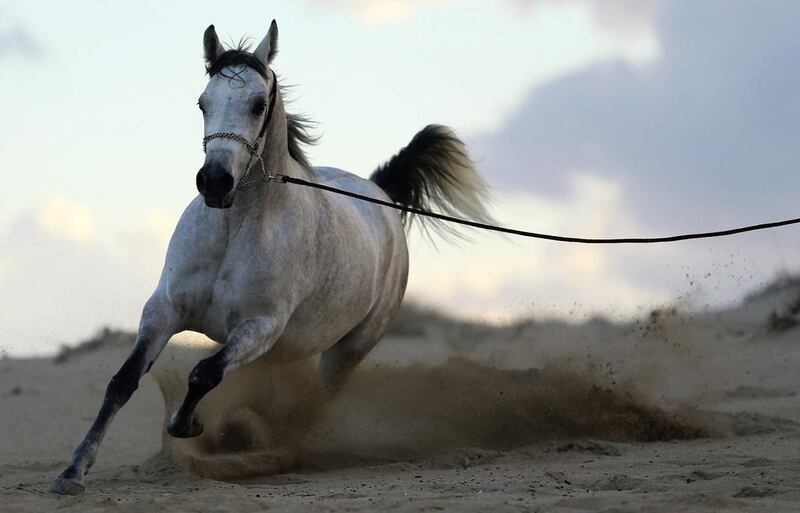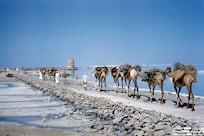Just 15 hairs per horse, each pulled out at the root, is all that Dr Anas Khanshour needed when he and his fellow scientists carried out genetic tests on Arabian horses from around the world.
As iconic for this region as the camel or the saluki, the Arabian horse is thought to be the oldest breed of riding horse and was closely linked to the spread of Islam.
Despite its importance, the emergence of this breed is partly shrouded in mystery, with scientists unsure exactly where or when it originated.
More than 250 horses from 11 populations of modern-day Arabian horses − including populations in Syria and Saudi Arabia, and those from further afield such as in Poland and the United States − were analysed by the research team that included Dr Khanshour, who was based at Texas A&M University.
Their focus was on a stretch of DNA from the mitochondria, energy-generating organelles found inside cells with their own DNA, inherited maternally and separate from that in cell nuclei.
What was notable was that haplotypes – groups of genes inherited from a single parent – were often shared between breeding lines or strains, which had names such as Abiah, Saklawia and Kahlila.
“The pedigree for the Arabian horses might not be 100 per cent matching the genetic story,” said Dr Khanshour, now a postdoctoral fellow at the Texas Scottish Rite Hospital for Children in Dallas.
That maternal lines were shared between strains suggested breeding had not been as rigorous as had been thought.
Dr Khanshour’s analysis also had interesting things to say on where the Arabian horse originated. Typically, geographical centres of origin show the greatest genetic variation, with populations further afield only having a portion of this variation.
An area in and around Syria therefore seems to be the most likely area of origin, because populations in this region have most variation.
“I believe these Arabian horses came from that particular region and most Arabian lines were related somehow to the Syrian lines on the maternal [side],” he said.
Dr Khanshour went to great effort to collect samples from the horses, some worth as much as Dh367,315 and hopes the genetic analysis could help breeding programmes. “It used to live in the desert where the temperatures are higher than 45C; you can look for the genes responsible for [positive physical characteristics],” he said. “It would be a very nice piece of research − not theoretical research.”
While Dr Khanshour has employed genetic analysis, a less technological approach has yielded results just as illuminating. Dr Sandra Olsen, a zooarchaeologist and curator at the Biodiversity Institute and Natural History Museum at the University of Kansas, has studied rock carvings, or petroglyphs, to understand the Arabian horse’s origins, in the absence of other evidence from the Arabian Peninsula.
“There’s been limited excavation in the region and there’s not very good bone preservation,” said Dr Olsen. “We would much rather have actual bones to look at but the rock art is a real gift.”
Petroglyphs in Saudi Arabia that show equines with Arabian features date to between 800 BCE and 200 CE, based on associated inscriptions.
Arabian horses are characterised by a concave facial profile, large eyes, small ears, a short back, an arched and powerful neck and high tail carriage. Many of the breed’s features, which include large flaring nostrils that help dissipate heat, were especially suited to its use in chariot warfare.
Images of chariots pulled by two generic horses, from the 2nd millennium BC, show the vehicles were lightweight and only built to carry one person; but later chariots, pulled by horses with strong Arabian features, are heavier, being designed to carry up to three people.
Perhaps tying in with the genetic evidence about where the breed may have originated, there are terracotta figurines from Syria, dating to 2300 BCE, that indicate a concave facial profile. However, these may be too simple to represent definitive evidence for the inception of the breed.
According to Dr Olsen, during the New Kingdom, the Egyptian Empire stretched up into this area, and there are records of Thutmose III (1479-1425 BCE) bringing horses and chariots back from Syria as war booty. By the time of Amenophis II (1427-1401 BCE), Arabian horses were commonly depicted in Egyptian tomb paintings.
For a forthcoming book Dr Olsen has edited, The Triumph of the Ancient Horse and Chariot, she has written a paper, The Inception of the Arabian Horse Breed, that reveals new details about how people interacted with the animals.
She thinks it is too early to draw conclusions about the much-discussed Arabian site of Al Magar, where some suggest a stone effigy of an equine could indicate the place of domestication of the horse itself as far back as 7,000 BCE. Dr Olsen has done much work to prove the presence of early domesticated horses in Kazakhstan, at about 3,500 BCE, and thinks that Ukraine or western Russia was probably where horses were first domesticated slightly earlier.
Although the earliest convincing images of Arabian horses were depicted in Egyptian tomb art from about 1,400 BCE, Dr Olsen said “we don’t know if the breed is earlier than that and just not clearly depicted anywhere.
“Currently, the archaeological record supports the genetic findings that Syria and surrounding areas appear to be the most likely source for this enduring breed”.
So the Arabian horse is likely to hold on to some of its secrets − at least for now.
newsdesk@thenational.ae







